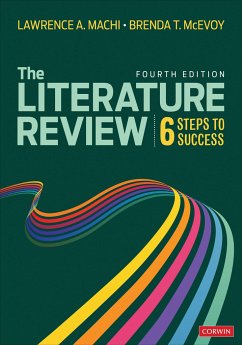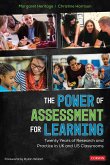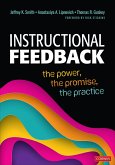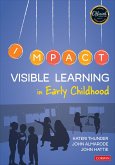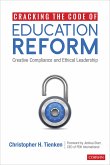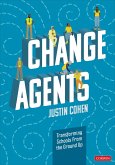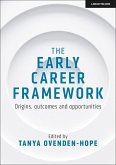- Broschiertes Buch
- Merkliste
- Auf die Merkliste
- Bewerten Bewerten
- Teilen
- Produkt teilen
- Produkterinnerung
- Produkterinnerung
The latest edition features new graphics illustrating the pioneering six-step model, tips for writing in the early stages, and new learning tools and reflection sections.
Andere Kunden interessierten sich auch für
![The Power of Assessment for Learning The Power of Assessment for Learning]() Margaret HeritageThe Power of Assessment for Learning39,99 €
Margaret HeritageThe Power of Assessment for Learning39,99 €![Instructional Feedback Instructional Feedback]() Jeffrey K. Smith (University of Otago, Dunedin, New Zealand)Instructional Feedback42,99 €
Jeffrey K. Smith (University of Otago, Dunedin, New Zealand)Instructional Feedback42,99 €![Visible Learning in Early Childhood Visible Learning in Early Childhood]() Kateri ThunderVisible Learning in Early Childhood42,99 €
Kateri ThunderVisible Learning in Early Childhood42,99 €![Cracking the Code of Education Reform Cracking the Code of Education Reform]() Christopher H. Tienken (Associate Professor Seton Hall University)Cracking the Code of Education Reform46,99 €
Christopher H. Tienken (Associate Professor Seton Hall University)Cracking the Code of Education Reform46,99 €![Change Agents Change Agents]() Justin CohenChange Agents42,99 €
Justin CohenChange Agents42,99 €![The Early Career Framework: Origins, outcomes and opportunities The Early Career Framework: Origins, outcomes and opportunities]() Tanya Ovenden-HopeThe Early Career Framework: Origins, outcomes and opportunities22,99 €
Tanya Ovenden-HopeThe Early Career Framework: Origins, outcomes and opportunities22,99 €![The Principal's Special Education Calendar The Principal's Special Education Calendar]() Joanne W. LaneThe Principal's Special Education Calendar31,99 €
Joanne W. LaneThe Principal's Special Education Calendar31,99 €-
-
-
The latest edition features new graphics illustrating the pioneering six-step model, tips for writing in the early stages, and new learning tools and reflection sections.
Hinweis: Dieser Artikel kann nur an eine deutsche Lieferadresse ausgeliefert werden.
Hinweis: Dieser Artikel kann nur an eine deutsche Lieferadresse ausgeliefert werden.
Produktdetails
- Produktdetails
- Verlag: SAGE Publications Inc
- 4 Revised edition
- Seitenzahl: 264
- Erscheinungstermin: 28. März 2022
- Englisch
- Abmessung: 255mm x 180mm x 20mm
- Gewicht: 522g
- ISBN-13: 9781071852903
- ISBN-10: 1071852906
- Artikelnr.: 63052761
- Herstellerkennzeichnung
- Libri GmbH
- Europaallee 1
- 36244 Bad Hersfeld
- gpsr@libri.de
- Verlag: SAGE Publications Inc
- 4 Revised edition
- Seitenzahl: 264
- Erscheinungstermin: 28. März 2022
- Englisch
- Abmessung: 255mm x 180mm x 20mm
- Gewicht: 522g
- ISBN-13: 9781071852903
- ISBN-10: 1071852906
- Artikelnr.: 63052761
- Herstellerkennzeichnung
- Libri GmbH
- Europaallee 1
- 36244 Bad Hersfeld
- gpsr@libri.de
Lawrence A. Machi is a Professor Emeritus of Organizational Leadership at the University of La Verne, in La Verne, California. He holds an MA in curriculum development and an Ed.D. in organizational leadership. He has taught research methods and design and has chaired doctoral dissertation research in addition to teaching classes in organizational development. He has extensive experience in higher education, and prior to his tenure at La Verne, he taught in schools of education at the University of San Francisco, St. Mary's College of California, and Sonoma State University. Dr. Machi has served as a Fulbright Specialist and recently completed his third assignment in Taiwan at National Chung Cheng University, where he currently serves as a visiting professor. With K-12 experience as well, he has worked as a secondary teacher and served as a school administrator in both secondary and elementary school districts in northern California. He has occupied the roles of vice principal, principal, assistant superintendent, and superintendent, frequently consulting with many California school districts and nonprofit organizations. His specialties are in the areas of organizational leadership, finance, negotiations, organizational development, and strategic thinking.
Literature Review Flow Chart
Preface
Acknowledgments
About the Authors
Introduction: Doing and Producing a Literature Review
Key Vocabulary
Introduction Overview
The Purpose of a Literature Review
The Literature Review Defined
The Literature Review Process
Mindset: Personal Dispositions on Thinking, Doing, and Deciding
The Ethics of Reviewing the Literature
Reflective Oversight
Plan Wisely Before You Begin
Summary
Checklist
Reflective Exercise
1. Step 1: Select and Define a Topic
Key Vocabulary
Chapter Overview
Task 1. Identify a Subject for Study
Task 2. Translate the Personal Interest or Concern Into a Research Query
Task 3. Link the Research Query to the Appropriate Discipline
Task 4. Write the Preliminary Research Topic Statement
Summary
Checklist
Reflective Exercise
2. Step 2: Develop the Tools of Argumentation
Key Vocabulary
Chapter Overview
Concept 1. Building the Case for a Literature Review
Concept 2. Arguments-the Basics
Concept 3. Evaluating the Basic Parts of an Argument
Concept 4. Understanding Claims
Concept 5. Building Evidence
Concept 6. Warrant-Logically Connecting the Evidence to the Claim
Concept 7. Complex Claims
Summary
Checklist
Reflective Exercise
3. Step 3: Search the Literature
Key Vocabulary
Chapter Overview
Task 1. Select the Literature to Review
Task 2. Conduct a Literature Search
Task 3. Refine Your Topic
Summary
Checklist
Reflective Exercise
4. Step 4: Survey the Literature
Key Vocabulary
Chapter Overview
Task 1. Assemble the Collected Data
Task 2. Organize the Information
Task 3. Analyze the Patterns of Data
Summary
Checklist
Reflective Exercise
5. Step 5: Critique the Literature
Key Vocabulary
Chapter Overview
What Is a Literature Critique?
Concept 1. Making the Case for the Literature Review
Concept 2. Descriptive Argument Patterns: Factual Reasoning
Concept 3. Implicative Argument Patterns: Implicative Reasoning
Concept 4. The Implicative Argument: Nine Basic Patterns
Concept 5. Backing
Doing a Critique of the Literature: Building the Advocacy Argument
Task 1. Determining the Implicative Logic Pattern Inferred by the Topic of
Study
Task 2. Reframe Claims to Meet the Prerequisite Conditions Identified by
the Selected Logic Type
Task 3. Build the Advocacy Argument
Concept 6. Fallacies
Concept 7. The Case Is Everything
Summary
Checklist
Reflective Exercise
6. Step 6: Write the Review
Key Vocabulary
The Writing Process: Overview
Task 1. Write to Understand
Task 2. Write to Be Understood
Style Manuals
Checklist
Reflective Exercise
Last Words
Supplements
Supplement A The Role of the Literature Review
Supplement B Literature Review 101
Supplement C Writing a Journal
Supplement D SQRRR
Glossary
References and Further Reading
Index
Preface
Acknowledgments
About the Authors
Introduction: Doing and Producing a Literature Review
Key Vocabulary
Introduction Overview
The Purpose of a Literature Review
The Literature Review Defined
The Literature Review Process
Mindset: Personal Dispositions on Thinking, Doing, and Deciding
The Ethics of Reviewing the Literature
Reflective Oversight
Plan Wisely Before You Begin
Summary
Checklist
Reflective Exercise
1. Step 1: Select and Define a Topic
Key Vocabulary
Chapter Overview
Task 1. Identify a Subject for Study
Task 2. Translate the Personal Interest or Concern Into a Research Query
Task 3. Link the Research Query to the Appropriate Discipline
Task 4. Write the Preliminary Research Topic Statement
Summary
Checklist
Reflective Exercise
2. Step 2: Develop the Tools of Argumentation
Key Vocabulary
Chapter Overview
Concept 1. Building the Case for a Literature Review
Concept 2. Arguments-the Basics
Concept 3. Evaluating the Basic Parts of an Argument
Concept 4. Understanding Claims
Concept 5. Building Evidence
Concept 6. Warrant-Logically Connecting the Evidence to the Claim
Concept 7. Complex Claims
Summary
Checklist
Reflective Exercise
3. Step 3: Search the Literature
Key Vocabulary
Chapter Overview
Task 1. Select the Literature to Review
Task 2. Conduct a Literature Search
Task 3. Refine Your Topic
Summary
Checklist
Reflective Exercise
4. Step 4: Survey the Literature
Key Vocabulary
Chapter Overview
Task 1. Assemble the Collected Data
Task 2. Organize the Information
Task 3. Analyze the Patterns of Data
Summary
Checklist
Reflective Exercise
5. Step 5: Critique the Literature
Key Vocabulary
Chapter Overview
What Is a Literature Critique?
Concept 1. Making the Case for the Literature Review
Concept 2. Descriptive Argument Patterns: Factual Reasoning
Concept 3. Implicative Argument Patterns: Implicative Reasoning
Concept 4. The Implicative Argument: Nine Basic Patterns
Concept 5. Backing
Doing a Critique of the Literature: Building the Advocacy Argument
Task 1. Determining the Implicative Logic Pattern Inferred by the Topic of
Study
Task 2. Reframe Claims to Meet the Prerequisite Conditions Identified by
the Selected Logic Type
Task 3. Build the Advocacy Argument
Concept 6. Fallacies
Concept 7. The Case Is Everything
Summary
Checklist
Reflective Exercise
6. Step 6: Write the Review
Key Vocabulary
The Writing Process: Overview
Task 1. Write to Understand
Task 2. Write to Be Understood
Style Manuals
Checklist
Reflective Exercise
Last Words
Supplements
Supplement A The Role of the Literature Review
Supplement B Literature Review 101
Supplement C Writing a Journal
Supplement D SQRRR
Glossary
References and Further Reading
Index
Literature Review Flow Chart
Preface
Acknowledgments
About the Authors
Introduction: Doing and Producing a Literature Review
Key Vocabulary
Introduction Overview
The Purpose of a Literature Review
The Literature Review Defined
The Literature Review Process
Mindset: Personal Dispositions on Thinking, Doing, and Deciding
The Ethics of Reviewing the Literature
Reflective Oversight
Plan Wisely Before You Begin
Summary
Checklist
Reflective Exercise
1. Step 1: Select and Define a Topic
Key Vocabulary
Chapter Overview
Task 1. Identify a Subject for Study
Task 2. Translate the Personal Interest or Concern Into a Research Query
Task 3. Link the Research Query to the Appropriate Discipline
Task 4. Write the Preliminary Research Topic Statement
Summary
Checklist
Reflective Exercise
2. Step 2: Develop the Tools of Argumentation
Key Vocabulary
Chapter Overview
Concept 1. Building the Case for a Literature Review
Concept 2. Arguments-the Basics
Concept 3. Evaluating the Basic Parts of an Argument
Concept 4. Understanding Claims
Concept 5. Building Evidence
Concept 6. Warrant-Logically Connecting the Evidence to the Claim
Concept 7. Complex Claims
Summary
Checklist
Reflective Exercise
3. Step 3: Search the Literature
Key Vocabulary
Chapter Overview
Task 1. Select the Literature to Review
Task 2. Conduct a Literature Search
Task 3. Refine Your Topic
Summary
Checklist
Reflective Exercise
4. Step 4: Survey the Literature
Key Vocabulary
Chapter Overview
Task 1. Assemble the Collected Data
Task 2. Organize the Information
Task 3. Analyze the Patterns of Data
Summary
Checklist
Reflective Exercise
5. Step 5: Critique the Literature
Key Vocabulary
Chapter Overview
What Is a Literature Critique?
Concept 1. Making the Case for the Literature Review
Concept 2. Descriptive Argument Patterns: Factual Reasoning
Concept 3. Implicative Argument Patterns: Implicative Reasoning
Concept 4. The Implicative Argument: Nine Basic Patterns
Concept 5. Backing
Doing a Critique of the Literature: Building the Advocacy Argument
Task 1. Determining the Implicative Logic Pattern Inferred by the Topic of
Study
Task 2. Reframe Claims to Meet the Prerequisite Conditions Identified by
the Selected Logic Type
Task 3. Build the Advocacy Argument
Concept 6. Fallacies
Concept 7. The Case Is Everything
Summary
Checklist
Reflective Exercise
6. Step 6: Write the Review
Key Vocabulary
The Writing Process: Overview
Task 1. Write to Understand
Task 2. Write to Be Understood
Style Manuals
Checklist
Reflective Exercise
Last Words
Supplements
Supplement A The Role of the Literature Review
Supplement B Literature Review 101
Supplement C Writing a Journal
Supplement D SQRRR
Glossary
References and Further Reading
Index
Preface
Acknowledgments
About the Authors
Introduction: Doing and Producing a Literature Review
Key Vocabulary
Introduction Overview
The Purpose of a Literature Review
The Literature Review Defined
The Literature Review Process
Mindset: Personal Dispositions on Thinking, Doing, and Deciding
The Ethics of Reviewing the Literature
Reflective Oversight
Plan Wisely Before You Begin
Summary
Checklist
Reflective Exercise
1. Step 1: Select and Define a Topic
Key Vocabulary
Chapter Overview
Task 1. Identify a Subject for Study
Task 2. Translate the Personal Interest or Concern Into a Research Query
Task 3. Link the Research Query to the Appropriate Discipline
Task 4. Write the Preliminary Research Topic Statement
Summary
Checklist
Reflective Exercise
2. Step 2: Develop the Tools of Argumentation
Key Vocabulary
Chapter Overview
Concept 1. Building the Case for a Literature Review
Concept 2. Arguments-the Basics
Concept 3. Evaluating the Basic Parts of an Argument
Concept 4. Understanding Claims
Concept 5. Building Evidence
Concept 6. Warrant-Logically Connecting the Evidence to the Claim
Concept 7. Complex Claims
Summary
Checklist
Reflective Exercise
3. Step 3: Search the Literature
Key Vocabulary
Chapter Overview
Task 1. Select the Literature to Review
Task 2. Conduct a Literature Search
Task 3. Refine Your Topic
Summary
Checklist
Reflective Exercise
4. Step 4: Survey the Literature
Key Vocabulary
Chapter Overview
Task 1. Assemble the Collected Data
Task 2. Organize the Information
Task 3. Analyze the Patterns of Data
Summary
Checklist
Reflective Exercise
5. Step 5: Critique the Literature
Key Vocabulary
Chapter Overview
What Is a Literature Critique?
Concept 1. Making the Case for the Literature Review
Concept 2. Descriptive Argument Patterns: Factual Reasoning
Concept 3. Implicative Argument Patterns: Implicative Reasoning
Concept 4. The Implicative Argument: Nine Basic Patterns
Concept 5. Backing
Doing a Critique of the Literature: Building the Advocacy Argument
Task 1. Determining the Implicative Logic Pattern Inferred by the Topic of
Study
Task 2. Reframe Claims to Meet the Prerequisite Conditions Identified by
the Selected Logic Type
Task 3. Build the Advocacy Argument
Concept 6. Fallacies
Concept 7. The Case Is Everything
Summary
Checklist
Reflective Exercise
6. Step 6: Write the Review
Key Vocabulary
The Writing Process: Overview
Task 1. Write to Understand
Task 2. Write to Be Understood
Style Manuals
Checklist
Reflective Exercise
Last Words
Supplements
Supplement A The Role of the Literature Review
Supplement B Literature Review 101
Supplement C Writing a Journal
Supplement D SQRRR
Glossary
References and Further Reading
Index

